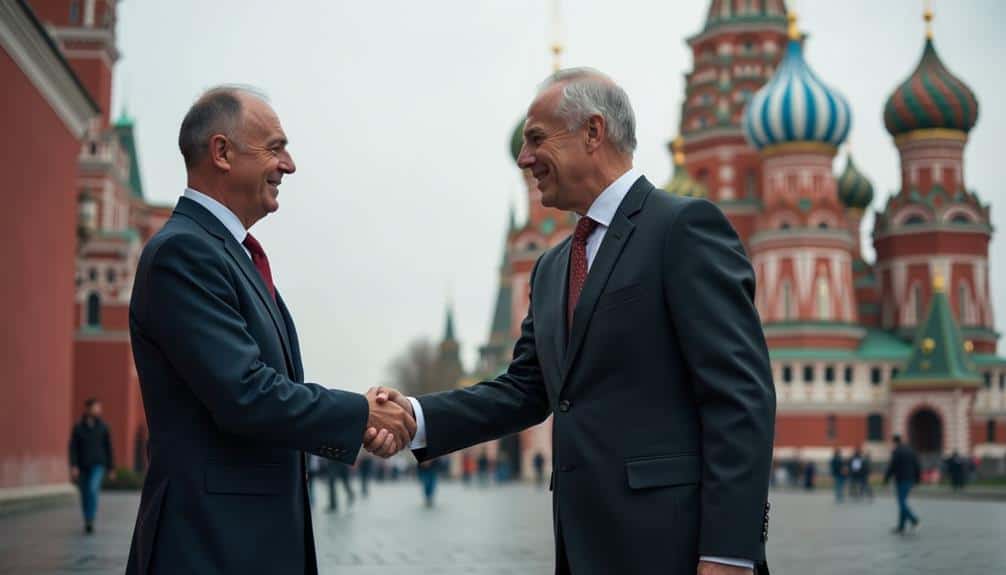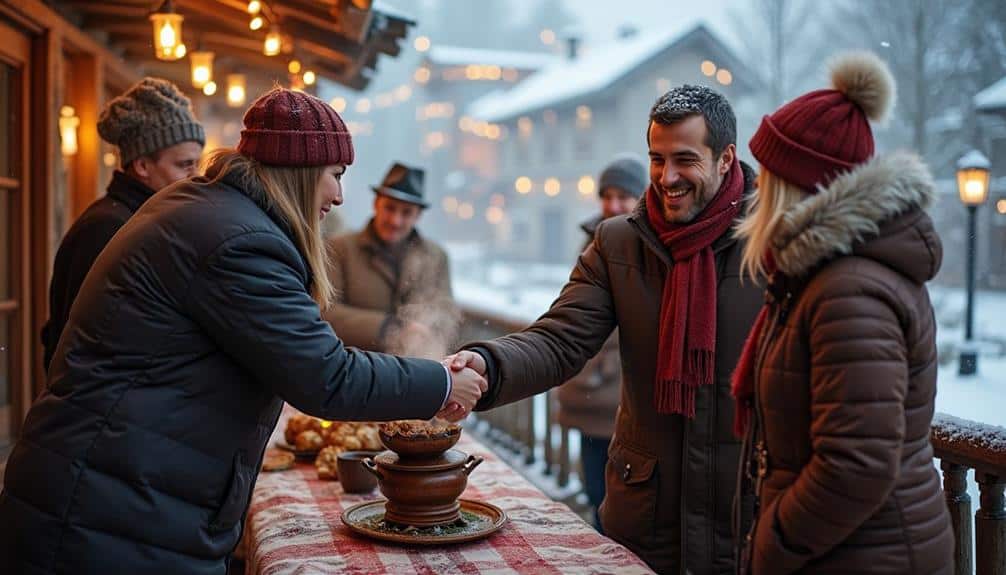Russian greetings and social interactions are a captivating blend of formality and warmth, reflecting a culture that places great emphasis on respect and authenticity. Initial encounters often involve firm handshakes and direct eye contact, setting the tone for reliability and sincerity. Notably, while smiles in casual exchanges are rare, a cheek kiss among friends is a common gesture of trust and friendship. Understanding the nuances of addressing individuals correctly, the significance of thoughtful gift-giving, and the intricacies of dining etiquette is essential for fostering meaningful connections. How do these complexities shape the dynamics of Russian social and business interactions?
Importance of First Impressions

In Russian culture, the importance of first impressions cannot be overstated. Rooted deeply within a rich cultural context, the initial encounter sets the tone for future interactions. Russians place significant emphasis on the way one presents oneself during a first meeting, as this can influence the trajectory of both personal and professional relationships.
Non verbal cues play a pivotal role during these first interactions. A firm stance, direct eye contact, and an attentive demeanor are often interpreted as signs of respect and sincerity. Russians value authenticity, and any perceived lack of it can lead to a strained relationship.
Additionally, the way one dresses is of considerable importance; attire should be neat, conservative, and appropriate for the occasion to convey respect and seriousness.
The cultural context of Russia, with its emphasis on tradition and formality, underscores the need for awareness and mindfulness when making first impressions. For those who cherish freedom and autonomy, understanding these nuances can be empowering.
Steering through these social norms adeptly not only fosters mutual respect but also opens doors to deeper, more meaningful connections within Russian society.
Handshakes and Their Significance
Building on the importance of first impressions in Russian culture, one of the most notable aspects of initial encounters is the handshake. In Russia, the handshake is not merely a casual gesture but a meaningful act laden with cultural significance. A firm, confident handshake is viewed as a sign of strength and reliability, essential traits in establishing trust.
Handshake variations can also convey different messages; for instance, a softer handshake might be perceived as a lack of confidence or interest, whereas a vigorous one could be seen as overly aggressive.
In professional settings, men typically shake hands upon meeting and leaving, often maintaining eye contact to express sincerity. It’s customary for men to initiate handshakes with women, though women may choose whether to reciprocate. This nuance in handshake variations highlights the broader cultural context where respect and intention are paramount.
In social contexts, the handshake retains its importance but is often accompanied by verbal greetings and, in some cases, a slight bow.
Understanding these subtleties in Russian handshakes can notably enhance one’s ability to navigate social and business interactions effectively, fostering connections that respect the deeply rooted cultural norms.
The Russian Smile

A Russian smile, often perceived through the lens of cultural nuance, serves as a window into the values and social norms of the country. Unlike in many Western cultures where smiles are frequently used in casual interactions, Russians typically reserve genuine smiles for close friends and family. This distinction underscores the significance of authenticity and sincerity in Russian social interactions.
In Russia, a smile is not merely a gesture of politeness but a reflection of true emotion. The cultural variations in the use of smiles can be intriguing for those who value freedom and individuality. In a society where trust and sincerity are highly regarded, a smile given freely and without genuine feeling might be viewed as insincere or even deceptive.
Consequently, Russians may seem reserved to outsiders, but this reserve is a reflection of their emphasis on meaningful connections. Understanding these cultural nuances is vital for fostering genuine interactions in Russia. Rather than interpreting a lack of smiles as unfriendliness, one should appreciate the depth of authenticity in Russian expressions of warmth and kindness.
Fundamentally, the Russian smile is a profound symbol of genuine human connection, deeply rooted in the country’s cultural fabric.
Cheek Kissing Etiquette
Understanding the nuances of Russian smiles sheds light on another significant aspect of social interactions: cheek kissing etiquette. In Russia, cheek kissing is a common form of greeting among friends and close acquaintances, but it carries specific cultural variations that one must respect. Typically, the gesture involves a series of three kisses, alternating cheeks beginning with the left. This rhythmic exchange is more than a mere formality; it symbolizes trust and mutual respect.
However, it is essential to recognize that cheek kissing is not universally employed in all social scenarios. In professional settings or when meeting someone for the first time, a firm handshake is generally preferred. Misinterpreting this norm can lead to awkwardness or even discomfort, highlighting the importance of context in Russian social customs.
Interestingly, the frequency and style of cheek kissing can also vary based on regional and generational differences within Russia. In urban areas, younger people might adopt a more European approach, limiting the kisses to only two, whereas older generations and rural communities often adhere to the traditional three kisses.
Addressing People Properly

In Russian social interactions, addressing people properly is paramount to demonstrating respect and understanding of cultural norms. Recognizing the importance of titles and name usage reflects one’s awareness of the cultural nuances inherent in Russian society. Typically, individuals are addressed by their first name followed by a patronymic, which is derived from the father’s first name. This formality signifies respect and is especially prevalent in professional and formal settings.
Additionally, regional variations can influence how people are addressed, with some areas exhibiting more traditional practices than others. For instance, in rural regions, it might be more common to use diminutives or affectionate forms of names among close acquaintances. Conversely, urban areas often adhere strictly to formal conventions, particularly in business environments.
Understanding these nuances allows one to navigate social interactions with ease, promoting a respectful and harmonious exchange.
It is also essential to note that the use of titles such as “Gospodin” (Mr.) and “Gospozha” (Mrs.) followed by the surname is still widespread, particularly in formal correspondence and introductions.
Formal Vs. Informal Speech
Although traversing the distinction between formal and informal speech in Russian can be complex, it is essential for effective communication. The Russian language exhibits a profound respect for hierarchy and social context, thereby necessitating a keen understanding of when to employ formal titles and when to relax into informal slang.
In formal scenarios, especially when addressing elders, professionals, or strangers, the use of formal titles such as “Gospodin” (Mr.) and “Gospozha” (Mrs.) is customary. This practice extends to using the respectful “vy” (Вы) instead of the informal “ty” (ты). Such distinctions underscore the importance of respect and delineate social boundaries.
Conversely, informal speech is prevalent among friends, family, and peers, fostering a sense of camaraderie and intimacy. Informal slang, characterized by colloquial expressions and the use of “ty,” serves to break down social barriers and cultivate a more relaxed atmosphere. Phrases like “privet” (hi) and “poka” (bye) are commonplace in these contexts, reflecting a more casual interaction.
Understanding when to toggle between these forms of speech not only enhances communication but also enriches social interactions, offering a deeper connection with the Russian culture and its people.
Giving and Receiving Gifts

Steering through the nuances of formal and informal speech lays a foundation for understanding another integral aspect of Russian social etiquette: the practice of giving and receiving gifts. In Russia, gift selection and presentation are imbued with cultural significance, reflecting respect and thoughtfulness.
When selecting a gift, consider the recipient’s preferences and cultural norms. Popular choices include high-quality chocolates, fine teas, and wines. Avoid giving yellow flowers, as they are associated with separation, and steer clear of overly expensive items, which may create discomfort.
Gift presentation is equally important. Russians appreciate beautifully wrapped gifts, often adorned with ribbons and decorative paper. Hand the gift over with both hands as a sign of respect.
When receiving a gift, it is customary to open it immediately in front of the giver, expressing genuine appreciation. This exchange is more than a mere transaction; it’s a gesture that fosters connection and mutual respect.
In professional settings, gifts should be modest and appropriate, such as a branded pen or a tasteful souvenir from your home country. Understanding these subtleties enhances your social interactions and demonstrates cultural sensitivity within Russian society.
Dining Etiquette
Steering through the intricacies of dining etiquette in Russia reveals much about the country’s rich cultural tapestry. When invited to a Russian household, expect a warm and hospitable environment, often accompanied by a lavish spread. Adhering to local table manners is essential to show respect and appreciation for your host’s efforts.
It is customary to wait until the host invites you to sit, and similarly, you should not start eating until the host has begun. Dining customs in Russia often include multiple courses, with each one showcasing the depth of Russian cuisine.
When it comes to table manners, politeness is key. It is considered polite to keep your hands visible but resting your elbows on the table is frowned upon. Toasts are an integral part of Russian meals, and it is common for the host or a guest to propose a toast before the meal begins.
Another notable aspect of Russian dining etiquette is the importance of finishing all the food on your plate, as leaving food behind may be interpreted as an insult to the cook. Understanding and respecting these dining customs not only enriches your experience but also fosters deeper connections with your Russian hosts.
Business Interactions

When engaging in business interactions in Russia, understanding the cultural nuances is essential for building successful relationships. Russian business culture places high value on personal connections and trust, which often necessitates taking the time to develop a rapport with potential partners.
Unlike the more transactional nature of Western business dealings, Russians appreciate a more relational approach. This cultural nuance can be pivotal in negotiations, where demonstrating respect and commitment can have a significant impact.
Russian negotiation styles tend to be direct and assertive, with a focus on achieving mutually beneficial outcomes. It is not uncommon for negotiations to be prolonged, as decision-making processes can be hierarchical and centralized.
Patience and persistence are critical, as rushing or pressuring can be counterproductive. Understanding and respecting this negotiation style can greatly enhance the likelihood of a successful agreement.
Furthermore, initial meetings often serve as a platform to gauge trustworthiness rather than to finalize deals. Being well-prepared, punctual, and professional are essential elements that convey seriousness and respect.
Common Social Faux Pas
Maneuvering social interactions in Russia requires a keen awareness of common faux pas to avoid inadvertently offending your hosts.
One prevalent cultural misunderstanding involves the concept of personal space. Unlike in some Western cultures where maintaining a certain physical distance is customary, Russians often stand closer during conversations. Interpreting this proximity as intrusive can lead to discomfort and miscommunication.
Similarly, stepping back might be perceived as unfriendly or distant, undermining the rapport you seek to establish.
Another common faux pas is the failure to show appropriate respect and politeness. In Russia, it is customary to greet everyone individually when entering a room, especially in smaller gatherings. Neglecting to do so can be seen as dismissive.
Additionally, addressing someone by their first name without using their patronymic (a middle name derived from the father’s first name) in formal settings can come across as overly familiar and disrespectful.




